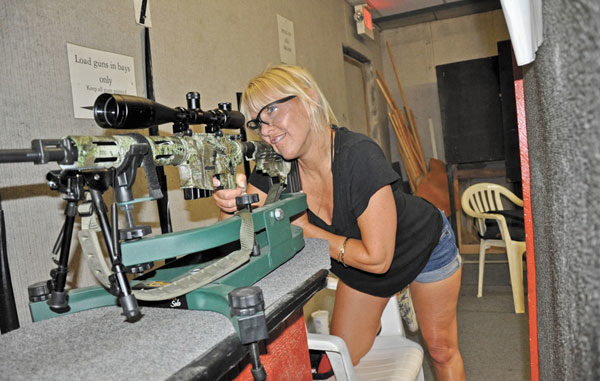
Every profession and every hobby has countless accessories, geegaws and knickknacks that supposedly make it easier to reach the final objective or goal — whether putting a ball in a hole or a projectile in a certain place on an animal or target.
Archery, for instance, has a seemingly endless supply of little “add-ons” for your bow to make your arrow launching easier, more accurate and more user-friendly.
Unlike a lot of these types of accessories that offer marginal advantages, it seems everything I add to my bow makes it easier to shoot and increases my skill level.
In rifle shooting, however, I’ve been a sort of hide-bound traditionalist.
Count me in the ranks of the old-timers who believe to shoot a rifle accurately you first have to have a solid rest, a couple of good sandbags and a quality scope, and the rest is practice. All the other fancy stuff is simply that — extra expense that rarely offers enough improvement to justify the cost of the accessory.
As an example of my hideboundness, I just recently came over to the realization that MSRs (modern sporting rifles — built on the U.S. military platform from which the M-16 rifle was derived) could be built in such a way as to produce accuracy that would rival the finest of bolt rifles — something I never considered possible,
Then a friend showed me what he could do with his own specially concocted handloads and his Remington R-15 semi-auto rifle.
I may be hide-bound, and a traditionalist, but I’m no fool. If a rifle will print three shots in one hole at 100 yards (his would), then I’m going to have one and try to accomplish the same goal.
When a friend, asking me to sight in his H&R Handi-Rifle in .45-70, offered the use of the camp’s Caldwell Lead-Sled, I all but sneered at the thought.
After all, I was the expert here. I’m not recoil-sensitive. Such recoil-reducing apparati were for the wussies in the clan. Why would big, tough, rifle-loving me EVER need such a silly thing as a “lead-sled.” I airily waved the offer away.
After three shots off the sandbags on my ATV, trying to make sure the boresighting job had put the muzzle of the rifles and the optical plane of the scopes somewhere in the same vicinity at 100 yards, I found my head ringing, a brutal headache tapping on the rearward wall of my braincase, and enough runny liquid dripping from my nostrils that I was checking for nosebleed.
Suffering for art in the face of more beatings and torture has never been my forte’. I asked for the Lead Sled.
These rifle rests, designed out of square tubing, have a padded “V” on the front in which you rest the forearm of your rifle. A Velcro strap is attached here to wrap around the barrel and forearm to lock them securely in place.
The bottom of the “sled” contains a tray in which you can put spent ammunition to keep track of it. These trays are actually designed to hold bags of lead shot to reduce the recoil from violently kicking rifles.
Believe me — the device offers enough dampening effect on most rifles, the added weight is not necessary.
If you are shooting a rifle with such a vicious recoil you simply must place some sort of weight in the trays to keep the “kick” to a manageable level, well, you must be hunting something not of this continent — maybe not of this dimension, for that matter.
The rear portion of the lead sled has a “shoe” into which you place the butt of your rifle. Your shoulder goes against the back of the shoe, instead of the butt of the rifle.
I was surprised — no, shocked — at what a solid rest I was able to maintain. Even with an “H” shaped Shooters’ Edge range bag, which allows the forearm of the rifle to rest securely, and a good sandbag for the “toe” of the butt of the stock, you will still find some minute movement while settling into the stock of the rifle.
With the lead sled on a solid table built into a concrete base, I had the most solid, non-moving sight picture I had ever experienced. And the recoil, upon touching the trigger, was negligible.
The results were exceptional. Both of the little Handi-Rifles sighted in by printing three shots at 100 yards within or right at 1-inch — I consider this incredible accuracy from a crack-barrel rifle with a removable forearm hanging from the barrel.
Obviously, H&R, with their firm establishment in the pecking order as beginners guns, or low-end shooters, has not skimped on the quality. Both of the rifles I fired were extremely well made and shot exceptional groups.
Did the Lead Sleds perform as promised? Suffice it to say I went out the next week and bought my own personal machine, and use it regularly now in the testing and shooting of my personal rifles.
I’m not so interested in its recoil-reducing properties (except when we have to sight in a .45-70 again) as I am in using it to maintain a perfectly steady hold on the rifle when I am shooting. No set of sandbags can match this, as it removes the human error — movement is reduced because you are not touching the rifle. It is locked in the lead sled — which is holding it in an immoveable position, and reducing the felt recoil at the same time.
It is an amazingly helpful piece of equipment, and now and forevermore has been removed from my own personal classification known as “extra, unneeded shooting geegaws.”


